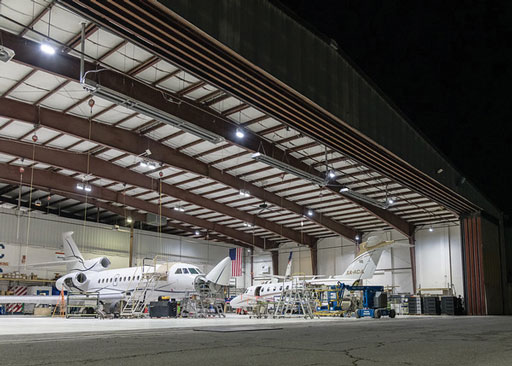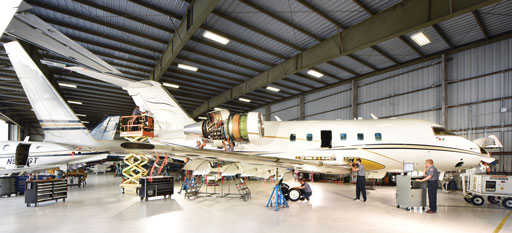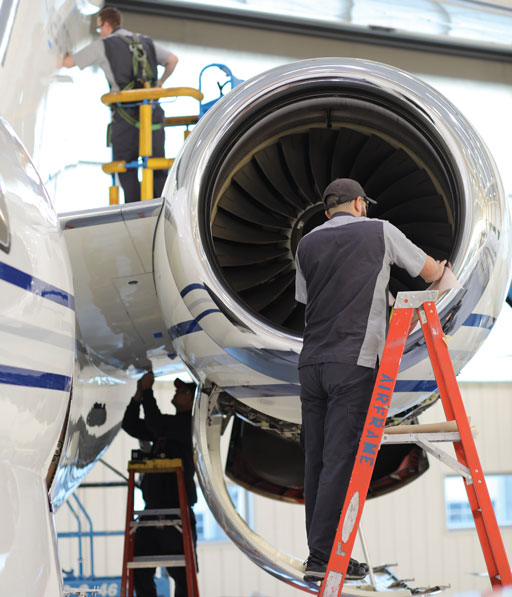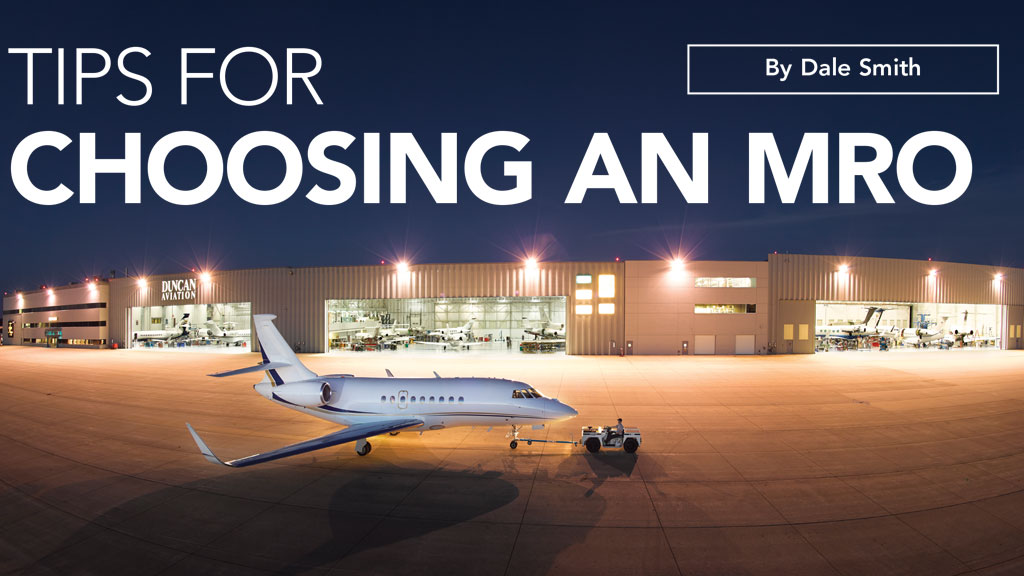Whether it’s piston, turboprop or jet, fixed- or swing-wing, sooner or later every business aircraft is going to need the care of an experienced maintainer. And like with every other type of service provider, it’s best to find the right one long before the work begins.
So, what do finding a great restaurant and choosing an MRO for your business aircraft have in common? Probably lot more than you think. Successfully finding either requires a blend of research, referrals and some really good luck.
And, like trying out the latest trendy international cuisine, the task of finding a quality MRO, without the heartburn, is made even more difficult if you are new to the particular aircraft in need of the work. After all, every aircraft is created from a unique recipe.
“If you are new to the particular type of aircraft, then the best first step is to ask around. Find other owner/operators with that same type and see who they use for maintenance,” explained Alan Monk, service sales manager for Duncan Aviation, Battle Creek, Michigan. “What you are going to be looking for is a shop that has a great reputation for its skill set, expertise, and knowledge about that type of aircraft.”
“It’s important for the owner/operator to be looking for a maintenance facility that best suits their needs as it relates to airframe capabilities, training, experience, downtime and their OEM relationships,” stated Banyan Air Service’s director of MRO services, Charlie Amento. “They have to be able to trust their maintenance facility to provide quality service, on time and as quoted – all with the customer’s needs being their top priority.”
The Hunt is On
That’s all well and good, but the question remains how do you go about finding an MRO that will meet all of your requirements. And, unlike scoping out a new restaurant, it’s not as easy as glancing at the latest reviews on Yelp.
As Randy Mengel, vice president and general manager of StandardAero’s Maryville, Tennessee facility explained, it’s vitally important to take the time to visit the MRO’s facility long before you need to schedule the work. Meet with their team. Look at how their facility is laid out. Is it clean and organized?
“The number one thing is to ask questions about their experience with your aircraft and about the skill levels of the technicians who will be working on your aircraft,” he said. “Also, ask to see referrals and references for other customers operating the same type of aircraft and then contact those references yourself.”
While we’re on the subject of asking and answering questions, all of our industry experts said that clear, honest and timely communications is a differentiating factor in the “to whom do I give my business” equation.
“Everyone has their own idea of what ‘good communication’ is and you need to make sure that the MRO’s team is prepared to meet your expectations. Ideally, the MRO will be proactive in telling you about how their ongoing communications are handled,’” Mengel said. “If they’re not, then you need to voice your expectations and the MRO needs to live up to them.”
“All companies say they are easy to work with but I would want to see examples of how they communicate,” Monk said. “All kinds of unforeseen issues can come up during the maintenance event whether it’s a discrepancy or an incident or just something that falls outside the work scope – you need open, honest, direct communications throughout the project.”
“It’s more difficult than it sounds. You need communications and transparency throughout the entire project. I don’t hide things from my customers and they don’t hide things from me,” he said. “Everyone needs to be clear on every issue and you have to be willing to listen and hear each other out when issues arise.”
“In my experience, there is rarely, if ever, one supreme correct opinion. You need to be open to working out every situation,” Monk said. “That is what I would be looking for if it were my airplane going in for a maintenance event.”
Yours, Mine and Ours…
It seems like one gigantic cliché, but you really do want to find an MRO that treats your airplane like it is one of theirs. You really want “white tablecloth” level service.
Our experts all agreed that one way to help assure that you are going to get that kind of attention is to select an MRO that is large enough to have dedicated service representatives – or whatever they call them – assigned to your airplane. One point of contact that is single-mindedly responsible for making you feel like the most important person or airplane in the shop.
“Banyan assigns a service manager as our ‘single point of contact’ from the beginning of the project to the end,” Amento said. “This ensures an open line of communication and helps build a trustworthy relationship with our customers.”
“Our MRO is all about partnering with the customer,” Don Campion, President of Banyan Air Service stated. “We ask ourselves, ‘What would we do if we owned the aircraft?’”
“We share what we believe brings the customer the most value when tasked with an inspection, modification, avionics upgrade or routine maintenance event,” he said. “Our goal is to customize our MRO services to enhance the benefit of personal aircraft use and ownership.”
“In the end, you are entrusting this organization and it’s people with your aircraft and money,” Campion said. “Make sure you’re comfortable knowing that you will be getting the service you are paying for.”
And speaking of money…
A Good Quote
One of the biggest hurdles you’ll face during the entire fine-an-MRO-process is getting comparable quotes from multiple. If they’re all over the place, you can waste hours trying to figure it all out. You’re probably sensing a pattern here, but again, it’s up to you to set the rules for what you expect in your quote.
“I would say the first step in getting an accurate quote is to provide the MRO’s sales representative, or whomever is doing the quote, with an accurate, well planned and highly detailed TO-DO list for the event,” Monk said. “It’s not hard to do. Most owners these days are on some kind of aircraft management program like CAMP and they have maintenance ‘Do Lists’ that the owner/operator can easily customize to their needs.”

Along with the “to-do” list, you also need to include all of the detailed information about the aircraft, its usage – if it’s on a Part 135 Certificate, for example – a detailed inventory of all recent maintenance tasks and modifications and whatever you feel is important for the MRO to know about. As long as it’s well organized and accurate, an MRO can never have too much information about your airplane.
“The important thing is you need to give the exact same information to every MRO you are shopping so they can give you a quote based on consistent information and expectations,” he said. “That way nothing is left open for interpretation or guesswork. Good shops never want to be put in the position of having to assume anything – they always get it wrong.”

And, it should go without saying, but here goes: If you change any specification or requirement to your to-do list, then make sure you share that will all the MROs involved. Your goal is to keep the proverbial playing field as level as possible.
Another way to approach your quote requests is to ask the shops if they offer “flat-rate” pricing for the particular type of work you need done.
“For many routine type inspections and maintenance needs, there is a lot of risk reduction with that pricing model,” Mengel said. “Of course, you have to make sure you fully understand any and all inclusions and exclusions contained in each shop’s flat rate price. Their work scopes can vary quite a bit.”
Mengel said that among the things you need to ask about are what kind of additional costs fall outside of the flat-rate price? And at what point does a component go “beyond economical repair?”
Also, don’t overlook the need to ask the shop about their warranty policy. No two are the same.

“You want the warranty program in writing before you deliver your airplane,” Mengel said. “How will they support their work after you take delivery and for how long? Three-, six, nine- or 12 months? How to they handle AOG situations if it’s related to the work they did in that timeframe? Don’t wait until it’s too late to ask.”
Some Things Just Won’t Add Up
Okay, the quotes are in and you’ve reviewed them in detail to make sure you fully understand what they include. The only problem is, one of them is way, way lower than the others. And while you may be temped to get that one signed before they realize their mistake, logic says this is not the time for a hasty decision.
“This is when I would ask them how many times they have completed this kind of work on your kind or airplane in the past year or so,” Monk said. “They may not have a clue as to the exact amount of work a particular inspection or maintenance task takes on your airplane. Now’s the time to reaffirm their level of experience.”
And, like in most things, the lowest quote is rarely the best quote.
“Settling with the least expansive option is often a big mistake,” Amento said. “Price is a big factor for most operators, but you should never jeopardize quality and service for a lower price. You have to look at the big picture and factor in all of the securities that come with the more reputable shop.”
“When it comes to maintaining a multi-million dollar asset like a business jet, it’s not about the lowest price, but which shop will bring you the best overall value? Who has the experience, knowledge, on-site technical representatives and overall customer service that will give you and your owner the best experience?” Monk said.
“Pricing is rarely the most important element in selecting the right shop for your situation – it’s more about the overall value they deliver,” Mengel said. “Some smaller MROs will provide a ‘teaser’ rate proposal to the owner just to bring them in the shop. Then hold the aircraft captive with all the add-on charges. It happens.”
“It’s not only about the pricing, but also the right scheduling and support. Remember, no part of an aircraft’s maintenance is a solitary event. It’s all connected,” he said. “The owner, operator or DOM needs to take a holistic view of the entire lifecycle of the MRO visit.”

Mengel’s mention of scheduling is something operators often tend to overlook. Depending on the aircraft type and level of maintenance being performed, the MRO representatives interviewed for this story are looking at shop space availability anywhere from three- to 12-months down the road.
“Many shops are understaffed, so planning well in advance gives you a better chance of getting the maintenance you need at the shop you want to work with,” Monk stated. “Sufficient planning will give the shop time to get all the necessary parts in stock and have room in the hangar so they can get the airplane in and out as efficiently as possible.”
“You can’t lose sight that the aircraft’s owner has their schedules also. They want the airplane when they want the airplane, so good long-range planning and coordination with the owner’s and the shop’s schedules will help avoid any unpleasant situations,” he said. “The closer you are to the date of the needed event, the less likely you are to be able to meet everyone’s schedules.”
“A very large inspection on a very large cabin aircraft may actually need to be scheduled a year out,” Monk said. “The more time the MRO has to plan the work, the better.”
